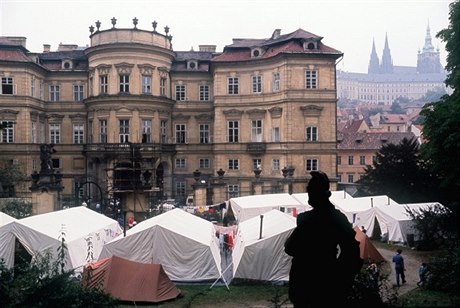For more than two decades, the debate over whether to sell Prague’s highly symbolic Lobkovicz Palace (sometimes spelt Lobkowicz), the seat of the Germany embassy where thousands of East Germans took refuge in 1989 as they sought to escape to the West, has been emotionally charged. There has been talk of irreplaceable cultural heritage, a palace of great historical significance for Czechs — and threats of protest by descendents of the Lobkowicz family.
It is, however, possible to take an objective and dispassionate look at the historical facts and contemporary situation. The baroque Lobkovicz Palace undoubtedly has great historical value, as it is a listed building, and adorned with objets d’art. In Prague, however, there are many similar buildings occupied by embassies from countries to which they were sold, for example the US, French, Italian and Romanian embassies.
Symbol of reunification
From the perspective of Czech history, the role and importance of the Lobkovicz Palace is relatively insignificant. After the family estate was sold to the Czechoslovak state in 1927 (here, the family questions the validity of the sale although it hasn’t belonged to it for 85 years), for some time it housed part of the Ministry of Education, an archaeological institution, and later the Ministry of Foreign Affairs. The latest state resident was the former Diplomatic Academy.
The People’s Republic of China had its seat there for some time and from 1973 until the present is the domicile of the representative office of Germany, for which it has a greater historical value. Composers such as Carl Maria von Weber and Ludwig van Beethoven performed there. But the fundamental importance for the Germans is that it is a symbol of the recent reunification of the country.
In was at the Germany embassy in Prague that in September 1989 over a thousand East German refugees descended hoping to escape the iron curtain — and where the then foreign minister Hans-Dietrich Genscher announced that they could freely travel to the West. At one point, some 4,000 were thought to be camping outside the building, sleeping in Trabant cars they latter abandoned, and in the grounds.
Void in valuation
Germany has therefore since the early ‘90s been looking to buy the Lobkovicz Palace, which would become a symbolic monument (the only of its kind abroad) to reunification. The Czech Republic was ready to sell in 1999 — a contract had even been drawn up — but for unspecified reasons withdrew from the discussion. Negotiations resumed in 2008 and are still underway.
By a resolution of May 11, 2001, the Czech government approved a plan to address the issue, which includes a formal approval to start (or rather resume) negotiations for the sale. The main sticking point is the price. It’s not enough to assess the value of the property, but all the resources and equipment that must remain in place.
The lack of experience on the part of the Czech state and professional agencies in the valuation of similar buildings has compounded the problem, but there is talk of a deal being reached in May. There is speculation the asking price will be in the hundreds of millions of crowns.
Brutal cubism
Selling the Lobkovicz Palace outright is only one possibility. Another involves the exchange of properties in Germany used by the Czech diplomatic services. These comprise:
- the current Czech embassy on Wilhelmstrasse in Berlin;
- the building that housed the former embassy in Bonn;
- an apartment complex in Berlin;
- the Ambassador’s residence in Berlin
For some (albeit not used) properties, such as the building in Bonn and the apartment complex in Berlin, a positive shift has occurred, and they could be sold at quite advantageous prices. But so far (22 years) an optimum solution regarding the fate of the main embassy building has proved fleeting.
The building is no baroque palace — it dates back to the mid ‘70s — and draws upon French brutalist and Czech cubist artistic traditions, with sharp angles and a blocky space age appearance. But the problem is not its appearance, but its oversized spaces (it was designed for 200 employees; 32 now work there), energy inefficiency, and poor state (nothing has been invested in it for decades).
Danger in delay
As an incentive to bring the Czechs back to the negotiating table over the sale of Lobkovicz Palace, Germany proposed a 2,500 square meter plot in the central district of Berlin that houses the embassies of many other countries. In terms of location, there is no better space in the German capital to build a diplomatic mission. It also has a historical significance for the Czechs, as it is just a hundred meters from where the embassy of the Czechoslovak First Republic was located until 1939.
When calculating all the above, the Czechs would get a good deal. The sale of Lobkovicz Palace would bring a considerable sum to state coffers. It would please the country’s main trading partner immensely. And in return, the Czechs would have a representative address for its diplomatic service in Germany.
Pluses
- Objects owned by the Czech Republic in Germany — market value at €19 million
- Lobkovicz Palace – worth several hundred million crowns
Minuses
- Price of land for the new embassy – an estimated €16 million
- Price of construction — depends on the scope of the project
In short, the price of properties sold in Germany would cover the costs of buying property in Berlin, including the cost of constructing a new building. The sale price of the Lobkovicz Palace would come as a bonus.
But the whole complex transaction must be resolved quickly. The Berlin Senate “reserved” the above land until mid-2012 only, at which time the Czech side is expected to finally make a decision. It would be a pity if, due to unnecessary and unjustified delays, this unique opportunity is passed by.




